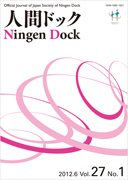Volume 27, Issue 1
Displaying 1-17 of 17 articles from this issue
- |<
- <
- 1
- >
- >|
Foreword
-
2012Volume 27Issue 1 Pages 5-6
Published: 2012
Released on J-STAGE: October 03, 2012
Download PDF (334K)
Editorial
-
2012Volume 27Issue 1 Pages 7-16
Published: 2012
Released on J-STAGE: October 03, 2012
Download PDF (524K)
Original Articles
-
2012Volume 27Issue 1 Pages 17-22
Published: 2012
Released on J-STAGE: October 03, 2012
Download PDF (459K) -
2012Volume 27Issue 1 Pages 23-28
Published: 2012
Released on J-STAGE: October 03, 2012
Download PDF (437K) -
2012Volume 27Issue 1 Pages 29-35
Published: 2012
Released on J-STAGE: October 03, 2012
Download PDF (794K) -
2012Volume 27Issue 1 Pages 36-40
Published: 2012
Released on J-STAGE: October 03, 2012
Download PDF (405K) -
2012Volume 27Issue 1 Pages 41-45
Published: 2012
Released on J-STAGE: October 03, 2012
Download PDF (465K) -
2012Volume 27Issue 1 Pages 46-55
Published: 2012
Released on J-STAGE: October 03, 2012
Download PDF (1301K) -
2012Volume 27Issue 1 Pages 56-59
Published: 2012
Released on J-STAGE: October 03, 2012
Download PDF (352K) -
2012Volume 27Issue 1 Pages 60-65
Published: 2012
Released on J-STAGE: October 03, 2012
Download PDF (675K) -
2012Volume 27Issue 1 Pages 66-72
Published: 2012
Released on J-STAGE: October 03, 2012
Download PDF (879K) -
2012Volume 27Issue 1 Pages 73-80
Published: 2012
Released on J-STAGE: October 03, 2012
Download PDF (544K) -
2012Volume 27Issue 1 Pages 81-86
Published: 2012
Released on J-STAGE: October 03, 2012
Download PDF (582K) -
2012Volume 27Issue 1 Pages 87-96
Published: 2012
Released on J-STAGE: October 03, 2012
Download PDF (2013K) -
2012Volume 27Issue 1 Pages 97-102
Published: 2012
Released on J-STAGE: October 03, 2012
Download PDF (851K) -
2012Volume 27Issue 1 Pages 103-107
Published: 2012
Released on J-STAGE: October 03, 2012
Download PDF (267K) -
2012Volume 27Issue 1 Pages 108-113
Published: 2012
Released on J-STAGE: October 03, 2012
Download PDF (434K)
- |<
- <
- 1
- >
- >|
